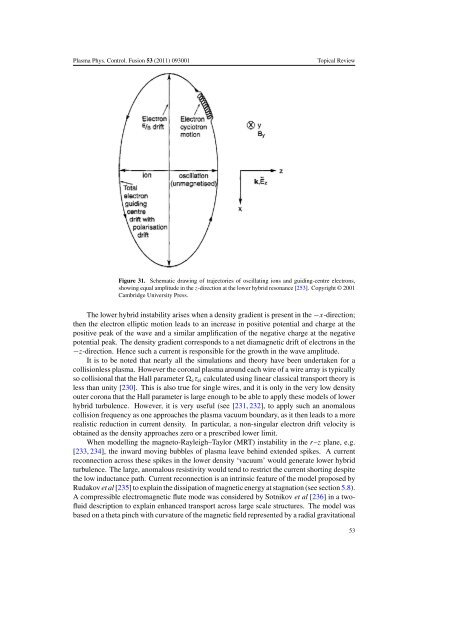You also want an ePaper? Increase the reach of your titles
YUMPU automatically turns print PDFs into web optimized ePapers that Google loves.
Plasma Phys. Control. Fusion 53 (2011) 093001<br />
Topical Review<br />
Figure 31. Schematic drawing <strong>of</strong> trajectories <strong>of</strong> oscillating ions and guiding-centre electrons,<br />
showing equal amplitude in <strong>the</strong> z-direction at <strong>the</strong> lower hybrid resonance [253]. Copyright © 2001<br />
Cambridge University Press.<br />
The lower hybrid instability arises when a density gradient is present in <strong>the</strong> −x-direction;<br />
<strong>the</strong>n <strong>the</strong> electron elliptic motion leads to an increase in positive potential and charge at <strong>the</strong><br />
positive peak <strong>of</strong> <strong>the</strong> wave and a similar amplification <strong>of</strong> <strong>the</strong> negative charge at <strong>the</strong> negative<br />
potential peak. The density gradient corresponds to a net diamagnetic drift <strong>of</strong> electrons in <strong>the</strong><br />
−z-direction. Hence such a current is responsible for <strong>the</strong> growth in <strong>the</strong> wave amplitude.<br />
It is to be noted that nearly all <strong>the</strong> simulations and <strong>the</strong>ory have been undertaken for a<br />
collisionless plasma. However <strong>the</strong> coronal plasma around each wire <strong>of</strong> a wire array is typically<br />
so collisional that <strong>the</strong> Hall parameter e τ ei calculated using linear classical transport <strong>the</strong>ory is<br />
less than unity [230]. This is also true for single wires, and it is only in <strong>the</strong> very low density<br />
outer corona that <strong>the</strong> Hall parameter is large enough to be able to apply <strong>the</strong>se models <strong>of</strong> lower<br />
hybrid turbulence. However, it is very useful (see [231, 232], to apply such an anomalous<br />
collision frequency as one approaches <strong>the</strong> plasma vacuum boundary, as it <strong>the</strong>n leads to a more<br />
realistic reduction in current density. In particular, a non-singular electron drift velocity is<br />
obtained as <strong>the</strong> density approaches zero or a prescribed lower limit.<br />
When modelling <strong>the</strong> magneto-Rayleigh–Taylor (MRT) instability in <strong>the</strong> r–z plane, e.g.<br />
[233, 234], <strong>the</strong> inward moving bubbles <strong>of</strong> plasma leave behind extended spikes. A current<br />
reconnection across <strong>the</strong>se spikes in <strong>the</strong> lower density ‘vacuum’ would generate lower hybrid<br />
turbulence. The large, anomalous resistivity would tend to restrict <strong>the</strong> current shorting despite<br />
<strong>the</strong> low inductance path. Current reconnection is an intrinsic feature <strong>of</strong> <strong>the</strong> model proposed by<br />
Rudakov et al [235] to explain <strong>the</strong> dissipation <strong>of</strong> magnetic energy at stagnation (see section 5.8).<br />
A compressible electromagnetic flute mode was considered by Sotnikov et al [236] inatw<strong>of</strong>luid<br />
description to explain enhanced transport across large scale structures. The model was<br />
based on a <strong>the</strong>ta <strong>pinch</strong> with curvature <strong>of</strong> <strong>the</strong> magnetic field represented by a radial gravitational<br />
53














